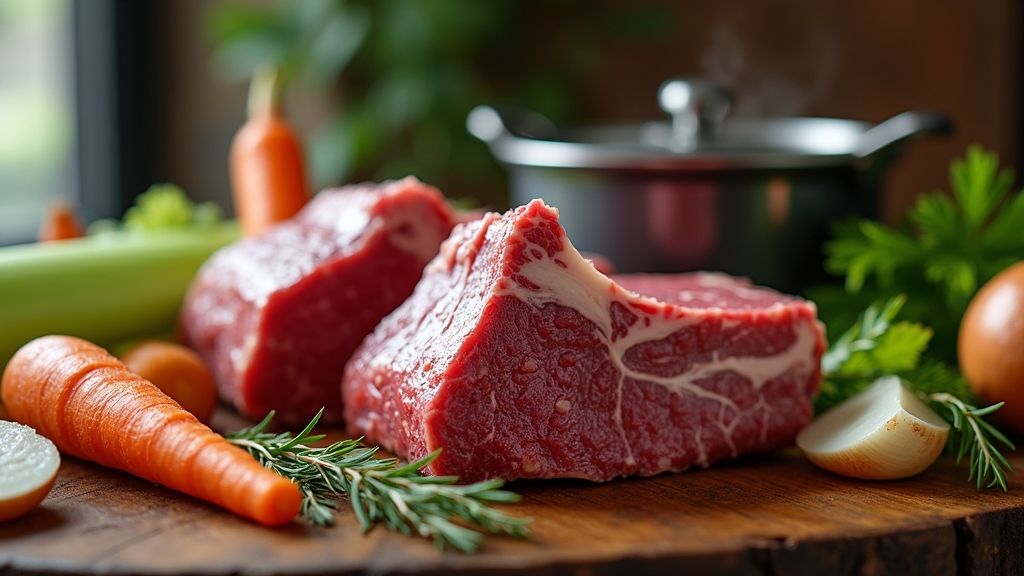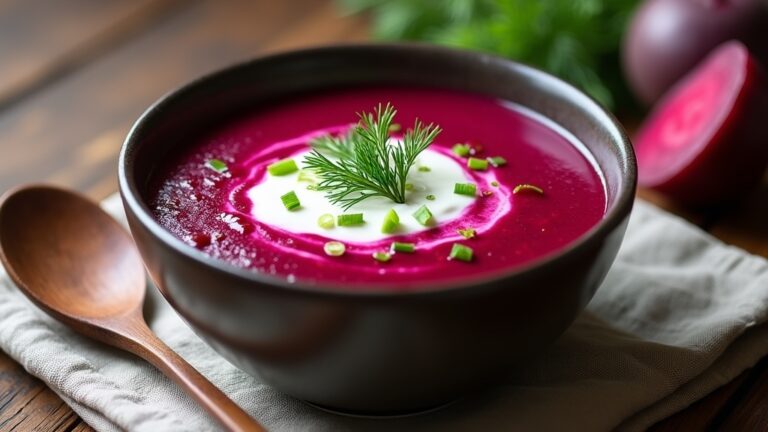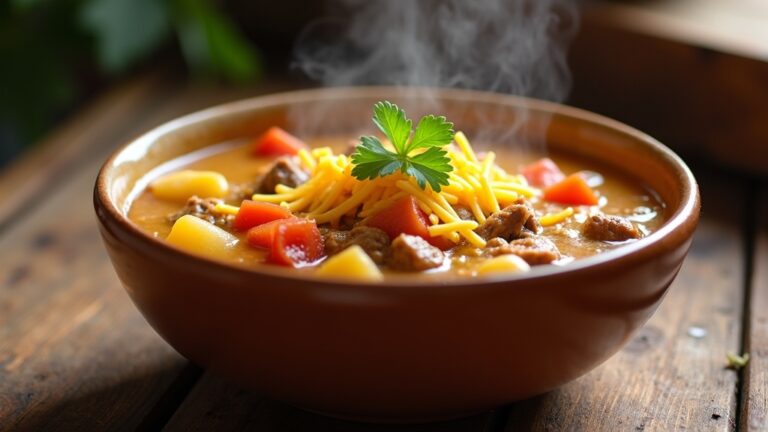Soup Bones Beef Recipe
When I make a beef soup using soup bones, I start by roasting high-quality bones to enhance that rich flavor. After rinsing them, I simmer them with aromatics like garlic and thyme, adding veggies for depth. The resulting broth is not just hearty; it’s packed with nutrients like collagen and iron. Each sip warms me up and nourishes me. If you’re curious about how to perfect this process, there’s more to discover!
Contents
History
When I think about beef soup bones, I’m reminded of how this humble ingredient has woven itself into the fabric of countless culinary traditions. Tracing back to ancient civilizations, the beef origins reveal a time when every part of the animal was valued for its nutritional richness. Cultures around the world have embraced soup bones, crafting broths that tell stories of sustenance and community. From hearty stews in European kitchens to fragrant pho in Vietnam, these bones symbolize resourcefulness and creativity. They transform simple ingredients into dishes that warm the soul. As I explore various culinary traditions, I can’t help but marvel at how beef soup bones continue to inspire innovation, blending history with modern flavors to create something truly unique.
Recipe
Beef soup bones are a fantastic way to create a rich, hearty broth that serves as the foundation for a variety of comforting soups and stews. Utilizing beef bones, particularly those with marrow and connective tissues, allows for a deeply flavorful stock that is both nutritious and satisfying. This recipe will guide you through the process of making a delicious beef bone soup that can be enjoyed on its own or as a base for other dishes.
Beef soup bones create a rich, nourishing broth perfect for comforting soups and stews.
To start, it’s important to choose high-quality beef bones, ideally from grass-fed beef, for the best flavor and nutrition. Roasting the bones before simmering them helps to enhance the depth of flavor in your broth. This soup is not only perfect for a chilly day but also serves as a base for many other recipes, making it a versatile addition to your meal planning.
Ingredients:
- 3-4 pounds beef soup bones (with marrow and connective tissue)
- 2 tablespoons olive oil
- 1 large onion, quartered
- 2 carrots, chopped
- 2 celery stalks, chopped
- 4 cloves garlic, smashed
- 2 bay leaves
- 1 tablespoon whole black peppercorns
- 1 tablespoon salt (adjust to taste)
- 12 cups water
- Fresh herbs (like thyme or parsley) for garnish
To cook the beef soup bones, preheat your oven to 400°F (200°C). Place the beef bones on a baking sheet and roast them in the oven for about 30-40 minutes until they are well-browned. In a large stockpot, heat the olive oil over medium heat, and then add the roasted bones, onion, carrots, celery, and garlic. Sauté for a few minutes until the vegetables begin to soften. Pour in the water, add the bay leaves, peppercorns, and salt, and bring the mixture to a boil. Reduce the heat to low and let it simmer for at least 4-6 hours (or longer for a richer flavor), skimming off any foam that forms on the surface. Once done, strain the broth and discard the solids, adjusting seasoning to taste before serving.
When cooking beef soup bones, patience is key. The longer you simmer the bones, the more flavor and nutrients will be extracted, resulting in a rich broth. For added depth, consider incorporating additional vegetables or herbs during the last hour of cooking. If you plan to store the broth, it can be refrigerated for up to a week or frozen for several months. Don’t forget to save some of the marrow from the bones; it’s a delicious treat that can be spread on toast or added back to the soup for additional richness!
Cooking Steps
Let’s get started on creating a rich and flavorful beef broth. First, I’ll prepare the beef bones and roast them to enhance their natural flavors. Then, I’ll simmer them with aromatics and vegetables, bringing everything together into a delicious soup base.
Step 1. Prepare the Beef Bones
Start by selecting high-quality beef bones, as they’re essential for a rich and flavorful soup. I always look for bones that have a good amount of marrow and connective tissue, which adds depth to the broth. During bone selection, I prefer a mix of knuckle bones, shanks, and oxtails for an ideal flavor profile. Once I’ve got my bones, I rinse them under cold water to remove any impurities. This simple preparation technique guarantees a cleaner broth. If you’re feeling adventurous, you can even soak the bones in a vinegar solution for an hour, which helps extract minerals and enhances the flavor. Properly preparing the bones sets the stage for a soup that’s truly remarkable.
Step 2. Roast Bones for Flavor
After preparing the beef bones, roasting them brings out a depth of flavor that transforms the broth into something special. I preheat my oven to 400°F and arrange the bones in a single layer on a baking sheet. Using various roasting techniques, I let them brown for about 30 to 40 minutes, turning them halfway through to guarantee even caramelization. That’s where the magic happens—the Maillard reaction creates those rich, savory notes that enhance the overall flavor of my broth. The aroma fills my kitchen, making it hard to resist. Once they’re beautifully browned, I can’t wait to add them to my pot. This simple step is key to achieving a robust, complex flavor profile in my soup.
Step 3. Simmer With Aromatics
Once the bones are roasted to perfection, it’s time to elevate the broth with aromatics that bring a symphony of flavors to life. I start by adding aromatic ingredients like garlic, fresh thyme, and bay leaves, letting their fragrances mingle in the pot. The heat releases essential oils, creating a tantalizing aroma that dances through the kitchen. I pour in cold water, ensuring the flavors infuse deeply as it simmers. This isn’t just about cooking; it’s about flavor enhancement that transforms a simple broth into something extraordinary. I let it bubble gently, allowing those aromatic ingredients to work their magic, enriching the broth with depth and complexity. Trust me, this step is where the real magic happens!
Step 4. Add Vegetables for Depth
As the broth simmers and the aroma fills the kitchen, I can’t resist the urge to add a medley of fresh vegetables that will deepen the flavor profile even further. I carefully consider my vegetable selection, opting for vibrant carrots, earthy celery, and robust parsnips. Each addition brings its unique essence, contributing to a harmonious blend. I sometimes toss in a handful of fresh herbs like thyme or parsley for extra flavor enhancement. As these vegetables soften, they release their natural sweetness, creating layers of complexity in the broth. I find that letting them mingle with the meat elevates the dish, making every sip a delightful experience. This is where innovation meets tradition—transforming a simple broth into something truly extraordinary.
Step 5. Strain and Serve Broth
With the vegetables now perfectly softened and their flavors fully integrated, it’s time to strain the broth. I grab a fine-mesh sieve and carefully pour the mixture, letting the rich liquid flow through while leaving behind the solid remnants. The aroma wafting up is simply intoxicating! Once strained, I like to taste the broth, adjusting seasoning if needed.
For broth storage, I recommend using airtight containers—this helps keep that vibrant flavor locked in. You can refrigerate it for a few days or freeze it for future culinary adventures. As for serving suggestions, consider a warm bowl topped with fresh herbs, or use it as a base for your favorite stew or risotto. Enjoy the warmth and comfort!
Nutritional Guide
When crafting a hearty beef soup from bones, it’s essential to reflect on the nutritional benefits that come with this comforting dish. Not only does it warm the soul, but it also provides necessary nutrients that support overall health. For those considering dietary implications, this soup can be a rich source of protein and minerals.
| Nutrient | Benefits | Dietary Considerations |
|---|---|---|
| Protein | Supports muscle growth | Necessary for all diets |
| Collagen | Promotes joint health | Great for skin elasticity |
| Iron | Boosts energy levels | Important for anemia |
| Zinc | Enhances immune function | Beneficial for recovery |
| Vitamin B12 | Supports brain health | essential for vegetarians |
Enjoy the nourishing qualities and innovate your meals!
Final Thoughts
Although preparing beef soup from bones might seem intimidating at first, I can assure you that the rewards are well worth the effort. The rich, flavorful bone broth you create not only warms the soul but also brings incredible soup benefits. This hearty dish is packed with nutrients and collagen, promoting joint health and boosting your immune system. Plus, the process of simmering bones fills your kitchen with an irresistible aroma, inviting creativity and comfort. By experimenting with spices and vegetables, you can craft a unique masterpiece that reflects your taste. So, embrace the challenge! Trust me, once you experience the depth of flavor and nourishment in your homemade beef soup, you’ll never look back. Happy cooking!
Frequently Asked Questions
Can I Use Different Types of Bones for This Recipe?
I love experimenting with different bone types. Each brings unique flavor profiles. For instance, marrow bones add richness, while knuckle bones contribute depth. Mixing them creates a delightful, complex broth that elevates any dish.
How Long Can I Store Leftover Soup?
I usually store leftover soup in airtight containers. It typically lasts about three to four days in the fridge. For longer shelf life, I freeze it—just remember to leave some space for expansion!
What Can I Add for Extra Flavor?
When I want to elevate my soup’s flavor, I love adding fresh herbs like basil or thyme, and spices such as smoked paprika. Flavor enhancers like soy sauce or a splash of vinegar work wonders too!
Is There a Vegetarian Alternative to Beef Bones?
I love using rich vegetarian broths or simmering roasted vegetables, mushrooms, and herbs together. These plant-based alternatives create a deep, flavorful base that’ll satisfy any palate while keeping things completely meat-free. Give it a try!
Can I Freeze the Soup for Later Use?
Absolutely, you can preserve your delicious creation! When freezing, I recommend using airtight storage containers. For best results, leave some space for expansion. Trust me, these freezing tips will keep your flavors intact for future enjoyment!
Conclusion
In the end, that pot of simmering soup bones transforms into a warm embrace, filling your kitchen with rich, savory aromas that dance in the air. Each spoonful tells a story of comfort and nourishment, wrapping you in a cozy blanket of flavor. As you savor the depths of each bite, you’ll realize that this humble dish is more than just a recipe—it’s a heartfelt connection to tradition, family, and the simple joys of home-cooked meals.











